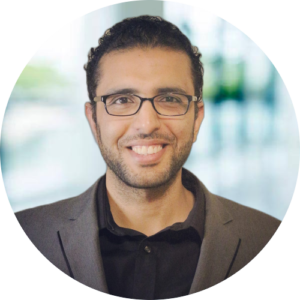 Dr. Mohamed (Moha) Ateia Ibrahim is a Group Leader and Environmental Engineer at the US EPA. Moha is an expert in the areas of emerging contaminants and the assessment of various separation and destruction technologies from lab-scale to Superfund sites. Inspired by the realization that conventional water treatment techniques will not be able to treat these problems, Moha have devoted himself to developing practical remediation solutions that draw on his expertise in engineering and chemistry. He focused on the assessment of conventional methods, the development of new materials and/or composites to adsorb/degrade micropollutants, and the mobility of new classes of contaminants in the environment (e.g., microplastics). He has initiated and led over a dozen of research collaborations with researchers across the world to target micropollutants in a practical way.
Dr. Mohamed (Moha) Ateia Ibrahim is a Group Leader and Environmental Engineer at the US EPA. Moha is an expert in the areas of emerging contaminants and the assessment of various separation and destruction technologies from lab-scale to Superfund sites. Inspired by the realization that conventional water treatment techniques will not be able to treat these problems, Moha have devoted himself to developing practical remediation solutions that draw on his expertise in engineering and chemistry. He focused on the assessment of conventional methods, the development of new materials and/or composites to adsorb/degrade micropollutants, and the mobility of new classes of contaminants in the environment (e.g., microplastics). He has initiated and led over a dozen of research collaborations with researchers across the world to target micropollutants in a practical way.
Read Mohamed’s Emerging Investigator Series article “Microplastics Sources, Fate, Toxicity, Detection, and Interactions with Micropollutants in Aquatic Ecosystems – A Review of Reviews” and read more about him in the interview below:
Your recent Emerging Investigator Series paper focuses on Microplastics Sources, Fate, Toxicity, Detection, and Interactions with Micropollutants in Aquatic Ecosystems – A Review of Reviews. How has your research evolved from your first article to this most recent article?
Recent progress in analytical chemistry has made it possible to detect a growing number of emerging contaminants (ECs) in natural and engineered water environments. Inspired by the realization that conventional water treatment techniques will not be able to treat these problems, I have devoted myself to developing practical remediation solutions that draw on my expertise in engineering and chemistry. Specifically, I have focused on the assessment of conventional methods (e.g., GAC, IX resins), the development of new materials and/or composites to adsorb/degrade ECs (e.g., PFAS, DBPs, PPCPs, illicit drugs), and the mobility of new classes of contaminants in the environment (e.g., microplastics). I have a multidisciplinary research background with hands-on experience in environmental engineering, materials chemistry, and agricultural engineering. I believe that solving global environmental challenges will require diverse expertise. Towards this end, I have initiated and led over a dozen research collaborations with researchers across the world to target ECs in a practical way.
What aspect of your work are you most excited about at the moment?
The most exciting and motivating aspect about my work is the positive impact on human health by contributing in protecting and treating water sources.
In your opinion, what are the most important questions to be asked/answered in this field of research? & 4. What do you find most challenging about your research?
The field of “emerging” contaminants is always challenged by the lack of information about detection methods and their sensitivities as well as comprehensive toxicological assessments. Once we can detect a contaminant and verify its toxicity, then we need to find its fate in a water/wastewater treatment plant and find novel solutions for the persistent contaminants. However, the magnitude of the problem is huge because the estimated number of chemicals and chemical mixtures is more than 350,000. Therefore, in addition to the experimental challenges/questions above, modeling efforts are needed more than ever before to deal with such large and branched problems.
In which upcoming conferences or events may our readers meet you?
I will be attending multiple meetings in March including ACS Spring Meeting and Water Environment Federation Summit.
How do you spend your spare time?
Before the pandemic, I used to travel a lot. Now, I like cooking and watching movies and documentaries.
Which profession would you choose if you were not a scientist?
I would work for an NGO.
Can you share one piece of career-related advice or wisdom with other early career scientists?
Establishing a strong network of connections is a key factor for success and it should start at the stage of graduate school. This network should include mentors and collaborators who give guidance and support. In addition, the network of early career scientists has a bridge with junior students and researchers as a way of training and knowledge transfer.










